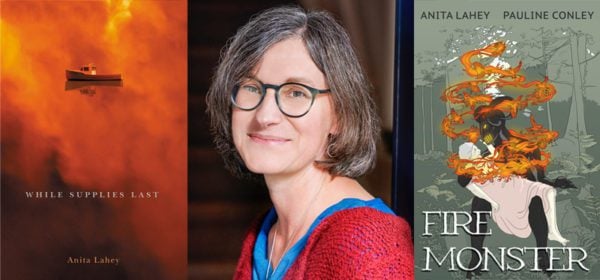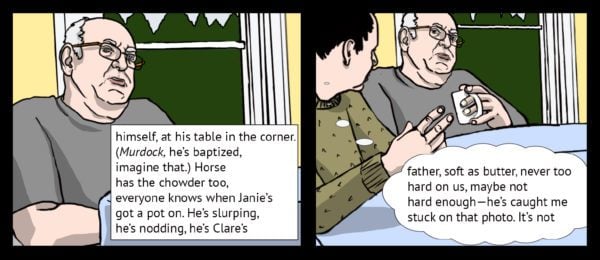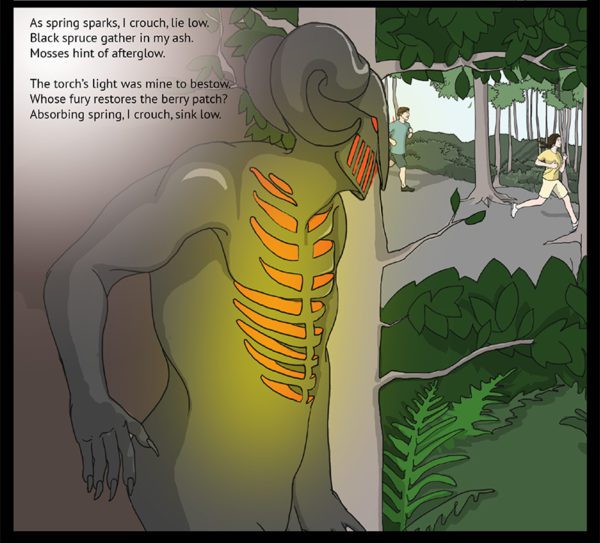
Anita Lahey (Colin Rowe)
If you ask Anita Lahey, she’ll say there seems to be “something in the air” in the literary community. There is, she thinks, “an openness to playing with the boundaries within which we normally work.” And indeed, Lahey’s work of late has been particularly interested in playing with and pushing against those boundaries, a move exemplified by Lahey’s collaboration with her friend, the artist Pauline Conley, on Fire Monster (Palimpsest Press, May), a unique, poignant, and genre-bending graphic novel in verse.
To really appreciate how the duo arrived at the publication of the illustrated, full-colour Fire Monster, one needs to look back at the 11-year-long collaborative process that brought this book to life. The story of Lahey and Conley begins when both were working at Arc Poetry Magazine, where they started to recognize that the poetry readership was growing ever smaller and more insular. As part of an effort, Lahey recalls, “to nudge poetry out of its poetry silo,” the two worked on initiatives that would unite poetry and the visual arts. For each issue they would commission a visual artist to create a piece inspired by a poem that would then be printed on a postcard and inserted in the magazine. “It was a way of bringing two art forms together and reaching beyond just the literary community.”
But, as Conley remembers, during their time at Arc, “We had more ideas than time, and so we didn’t get to do all the things that we were excited about doing.” Thankfully, once they had both moved on in their careers, they maintained a close friendship and continued discussing poetry, visual art, and the great potential of combining the two. It was in the course of one of those conversations that the idea behind Fire Monster first took shape. Conley recalls “standing in Anita’s kitchen in Toronto, and talking about how much we missed working together, and that’s when she gave me this idea: Do you want to do something with this cycle of poems I’ve written? And I said, yes.” The importance of conversation and of friendship is a theme that marks the book’s production and emerges throughout the text.
Active collaboration in the creation of this project spanned years. Lahey would write some poems after extensive research into the great fire of Main-à-Dieu, a historical event that fascinated her as a child – a wildfire in 1976 nearly wiped out the tiny fishing village on the eastern coast of Cape Breton. (Although she grew up in Burlington, Ontario, Lahey’s father is from Main-à-Dieu and she still has strong ties to the area.) Conley would read the poems and start providing illustrations. The art, in turn, spurred Lahey to new writing, or to edit some of the existing poems. Both women describe the process as deeply reciprocal. In 2020, several years into this back-and-forth collaboration – “maybe halfway through us working on it,” says Lahey – they published the existing material as a chapbook titled The Great Fire of Main-à-Dieu with Karen Schindler’s Baseline Press. The text in this earliest form is not a comic, but rather a short collection of poems accompanied by Conley’s gorgeous illustrations.

(Pauline Conley)
Lahey says it was Conley who realized the graphic-novel potential of their work: “I think one of the poems turned into a dialogue for her. So, she thought: I’m going to put this into a comic strip and see what happens.” Once the two saw the poems brought to life in Conley’s comics, they were able to envision what the finished product could look like. Conley started pulling characters out of Lahey’s poems. Lahey, when confronted with the fully visualized image of a character, often realized that the character – including the fire, which is personified – needed to be described in another way, or would talk rather differently than the poem initially allowed, or even required their own separate section.

(Pauline Conley)
Some of the poems from this project also form the section “The Great Fire of Main-à-Dieu” in Lahey’s While Supplies Last, published in April under Véhicule Press’s Signal Editions imprint, a collection that is itself deeply researched, thoughtful, and varied in its forms, though it is a traditional collection of poems. In While Supplies Last, Lahey takes inspiration from a wide variety of things, ranging from historical events, like the fire, to the subterranean waterways found throughout Toronto and the concept of urban foraging (featured in the poem “Saskatoon Berries by Value Village”), to the traffic reports that inspire a section titled “Pandemic Traffic Reports.” On that last topic, Lahey is very enthusiastic: “The guy who does the traffic reports here in Ottawa on CBC Radio (Doug Hempstead), in our household we find him quite funny.” The poems in that section bring together that humour with the strange isolation of the pandemic; the result is another kind of collaboration – between Lahey and Hempstead’s traffic reports, though the latter was not made aware of her work.
This issue of collaboration – of voices, forms, and various autonomies coming together – has become central to Lahey’s poetics. You might worry that adding another voice into the process would make writing more difficult or more limited, but for Lahey, collaboration actually opens the process up. When collaborating with Conley especially, “I felt more free to play with the way I was handling the poem, like the poem wasn’t just about me doing whatever happens when you sit down to write a poem and working something out on your own.”
Correction, April 26: This story has been updated from the original to correct Anita Lahey’s hometown. She did not grow up in Cape Breton or near Main-à-Dieu.
 Contact us via email
Contact us via email

